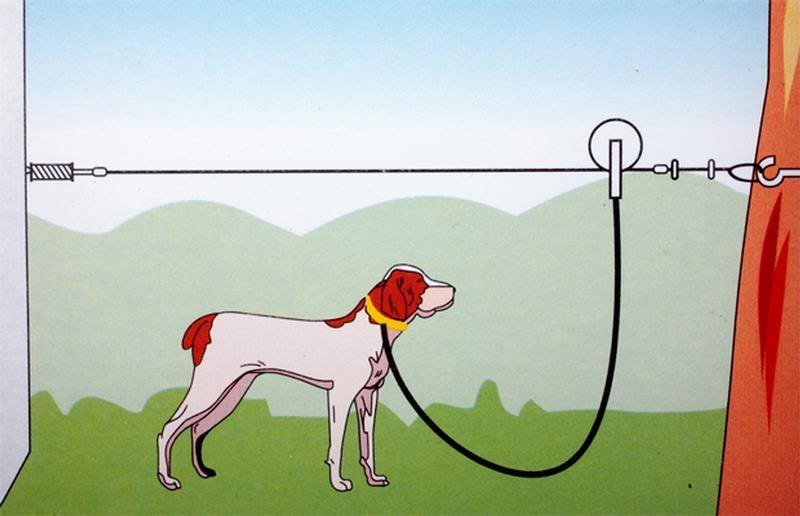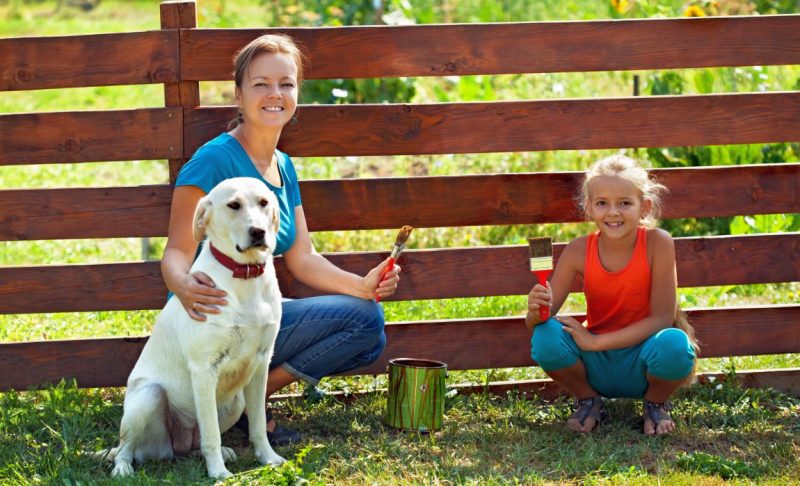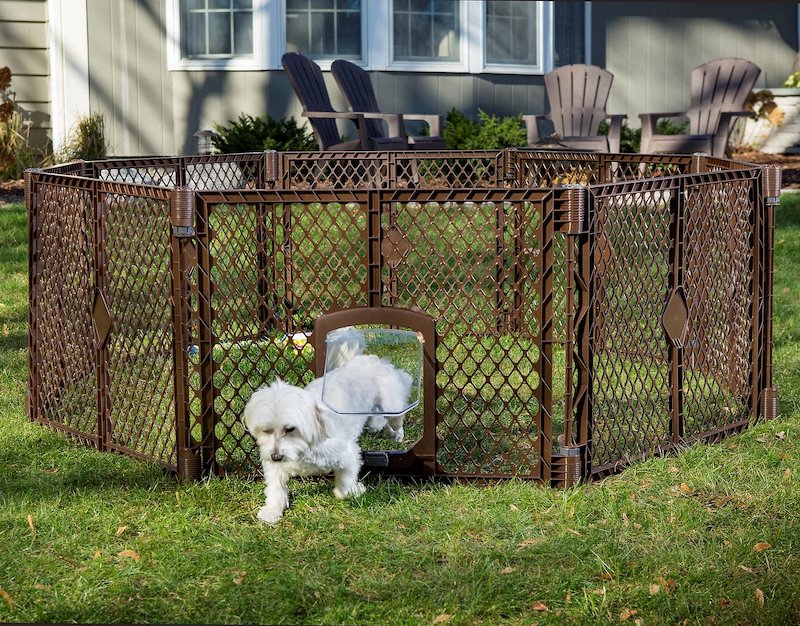Some owners and prospective owners are going to be upset by my viewpoint. Nevertheless, its based on my experience, research, and common sense.
Yes, dogs need and deserve a fenced area where they can walk around and burn some energy, especially on grass or dirt, several times per day.
You would have to lead your dog outside even for bathroom breaks if your yard wasn’t fenced. That is definitely unfair to any dog that is bigger than a Chihuahua. Dogs don’t like being constantly attached to a leash
It is feasible to get by with an outdoor exercise pen (also known as an “ex-pen”), especially if the dog is small. Here, a set of wire panels opens up to create an enclosure where your dog is free to run around without a leash.
The pen in the image is much too small, but you can purchase several of them and connect them to create a much larger space. You could purchase three Midwest exercise pens, for instance, to create a 12 foot by 12 foot enclosure if you search for “Midwest exercise pen” on Amazon. A 16 foot by 16 foot enclosure could be created with four pens. Bigger is better!.
Check with your homeowners association if you live in a subdivision to see if they permit this. Since it is temporary fencing, they might consent to its continued use. Alternatively, they might demand that you set it up and take it down each time you use it. That wouldnt work so well.
Any enclosure should be very, very close to your house. Keep in mind that you must take your dog out several times throughout the day, including just before bed and in inclement weather. So it needs to be close to the house.
Tie Outs, Tethers, or Trollies
Tie out procedures entail using a rope or chain to keep your dog where you want her to remain.
Some must be anchored into the ground with stakes, while others are more transient and meant to be fastened to trees and other sturdy objects.
Others have sliding, mobile anchors that essentially give your dog access to the entire backyard, while some anchor to a fixed point and only provide a small amount of running space.

Many of these are very simple to install and might be ideal for your needs.
In our article on dog tie-out and trolleys, we go over some of the benefits and drawbacks of the various systems and assist you in choosing the best one for your needs.
Tethers and trolleys should not be used in the backyard unattended because dogs could become entangled in the ropes or chains. Therefore, you should only use these when you can watch over your pet.
One of the more time-consuming but also one of the less expensive fence alternatives is boundary training. You simply need to train your dog to stay in your yard.
If you’ve never heard of it being done before, it may sound a little crazy, but it is possible.
There are many different ways to work on boundary training.
Some property owners already have natural borders around their yards (such as extensive gravel or dog-friendly mulch strips along the borders), which makes teaching your dog the boundaries of the yard a little bit simpler.
During initial training, other owners might need to add some sort of observable boundary, like a rope or flags.
You’ll begin by walking your dog around the yard while it is attached to a lead. Reward your dog when it stays inside the designated boundary area. When your dog crosses the line, take them back into the proper area right away and give them a treat.
You’ll gradually start to circle the perimeter with them as compensation for them staying inside the fence. In time, you’ll encourage your dog to stay inside the boundary as you walk on the outside while also tossing treats into the inner part of your yard.
It takes a while, but it’s the best method for people who want to keep their dogs in the yard without using physical force.
Despite this, we do not suggest relying solely on this technique. Dogs can still be taken from their owners, chased by other dogs, or distracted by a wild animal.
It works well when you and your dog are outside, but you shouldn’t rely on it when you leave your dog outside alone.
In order to give your dog more freedom in the yard while you’re there, you can use a long line, which is simply a long leash, rope, or tether.
It functions similarly to the tethers or tie-outs mentioned above, but is typically attached to you rather than a permanent anchor.
Using one gives your dog the opportunity to travel across a lot of ground while staying secure inside the confines of your property.
While using this, you’ll obviously need to be outside with your pet because it’s not necessarily a long-term solution. However, a long line can come in handy immediately or whenever you’re lounging in the yard with your pet.
A DIY fence might be a good option if you want a fence but don’t want to spend a ton of money on a conventional one. A DIY fence will not only be easier on your wallet, but it can also be modified to meet your unique needs.
There are numerous DIY fence options to take into consideration, but be realistic about your finances, your dog’s ability to escape the yard, and your own building abilities.

A quick alternative that doesn’t involve training for your dog is an exercise pen.
An exercise pen is essentially a tiny fenced enclosure that you can set up in your backyard. It won’t grant your dog access to your entire yard, but it also won’t require much of your time.

Puppies benefit most from these exercise pens because they don’t need a lot of space to play but need a lot of time to do so. You can also bring many exercise pens inside to keep an untrained puppy confined to a certain room or area.
These pens might be less helpful for bigger dogs, though.
The size of the pen must be larger the larger the dog. The more substantial the pen, the more challenging it will be to move.
In these situations, you might want to choose a dog run or outdoor dog kennel instead.
How To Keep Your Dog In The Yard Without a Fence
It can be challenging to keep a dog outside without a fence. In addition to the fact that letting dogs run loose in some areas is actually against the law, many dogs left outside unattended are likely to encounter problems sooner rather than later.
Of course, giving dogs a lot of space to romp around is fantastic. If you live in the country, you are probably pleased that your dog has the significant benefit of having access to large tracts of land, which is ultimately a luxury today given that fewer and fewer dogs are able to enjoy this degree of unrestricted freedom. However, it is not without trouble.
The truth is that many dogs who are left outside on their own run the risk of engaging in undesirable behaviors like digging up your garden, consuming rocks, chasing passing animals, and occasionally chasing cars.
Additionally, dogs kept off-leash in an unfenced area without restraints run a number of risks, some of which can be very serious. Not everyone is though aware of these risks. This is the reason I’ve compiled this sobering list of the numerous risks associated with letting dogs run free.
How Can I Keep My Dog Outside Without a Fence?
Let’s face it: Traditional fences can be very expensive. You might not be able to build a fence because you reside in a neighborhood where fences are prohibited, or you may have had a company come by and give you an estimate that caused sticker shock.
There often seems to be no solution, which can be very frustrating. In those situations, what can you do to keep your dog secure yet happy?
Fortunately, there are a number of options to think about that can help you and your dog come to an amicable agreement. Let’s examine some substitutions for conventional dog fences.
FAQ
Can you have a dog with no fence?
Yes, there are other ways to keep your dog contained while allowing them to enjoy the great outdoors. These consist of barrier training, long lines, pens and runs, invisible fences, and tie-outs.
How do you keep a dog without a fence?
- Invisible Fence. When your dog crosses the boundary, an electric device called an “invisible fence” gives her a small static shock.
- Tie Outs, Tethers, or Trollies. …
- Boundary Training. …
- Long Line. …
- Build Your Own Fence. …
- Exercise Pen.
What dogs dont need a fenced yard?
…
- Bulldog. …
- Cocker Spaniel. …
- Cavalier King Charles Spaniel. …
- Maltese. …
- Golden Retriever. …
- Labrador Retriever. …
- Vizsla. …
- Old English Sheepdog.
How can I keep my dog in my yard without an invisible fence?
When unable to completely enclose their yard with fencing, many owners install a trolly line. You can string this line between two buildings (like your house and a tree). So that your dog can enjoy the great outdoors without constant supervision, you next attach a leash to a pulley.